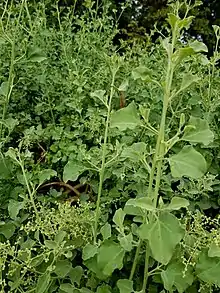| Chenopodium parabolicum | |
|---|---|
.jpg.webp) | |
| Chenopodium parabolicum (left plant) | |
| Scientific classification | |
| Kingdom: | Plantae |
| Clade: | Tracheophytes |
| Clade: | Angiosperms |
| Clade: | Eudicots |
| Order: | Caryophyllales |
| Family: | Amaranthaceae |
| Genus: | Chenopodium |
| Species: | C. parabolicum |
| Binomial name | |
| Chenopodium parabolicum (R.Br. ) S.Fuentes & Borsch | |
| Synonyms | |
|
Rhagodia parabolica R.Br. | |

Chenopodium parabolicum.
Chenopodium parabolicum[1] (Syn. Rhagodia parabolica), commonly known as fragrant saltbush or mealy saltbush, is a shrub in the family Amaranthaceae. The species is native to Australia.
The species was formally described in 1810 in Prodromus Florae Novae Hollandiae by botanist Robert Brown.[2] In 2012, after phylogenetical research, it was reclassified as a species of Chenopodium, and assigned the name Chenopodium parabolicum (R.Br.) S.Fuentes & Borsch.[1]
The species occurs in South Australia, Victoria, New South Wales and Queensland.[3]
References
Wikimedia Commons has media related to Chenopodium parabolicum.
Wikispecies has information related to Chenopodium parabolicum.
- 1 2 Susy Fuentes-Bazan, Guilhem Mansion, Thomas Borsch: Towards a species level tree of the globally diverse genus Chenopodium (Chenopodiaceae). In: Molecular Phylogenetics and Evolution. Vol. 62, No. 1, 2012, ISSN 1055-7903, p. 372, DOI:10.1016/j.ympev.2011.10.006
- ↑ "Rhagodia parabolica". Australian Plant Name Index (APNI), IBIS database. Centre for Plant Biodiversity Research, Australian Government, Canberra. Retrieved 13 April 2012.
- ↑ Jacobs S.W.L. "Rhagodia parabolica R.Br". PlantNET - New South Wales Flora Online. Royal Botanic Gardens & Domain Trust, Sydney Australia. Retrieved 13 April 2012.
This article is issued from Wikipedia. The text is licensed under Creative Commons - Attribution - Sharealike. Additional terms may apply for the media files.